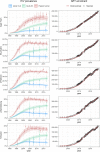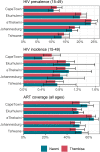Modelling of HIV prevention and treatment progress in five South African metropolitan districts
- PMID: 33707578
- PMCID: PMC7952913
- DOI: 10.1038/s41598-021-85154-0
Modelling of HIV prevention and treatment progress in five South African metropolitan districts
Abstract
Globally, large proportions of HIV-positive populations live in cities. The Fast-Track cities project aims to advance progress toward elimination of HIV as a public health threat by accelerating the response in cities across the world. This study applies a well-established HIV transmission model to provide key HIV estimates for the five largest metropolitan districts in South Africa (SA): Cape Town, Ekurhuleni, eThekwini, Johannesburg and Tshwane. We calibrate the model to metro-specific data sources and estimate progress toward the 90-90-90 targets set by UNAIDS (90% of people living with HIV (PLHIV) diagnosed, 90% of those diagnosed on antiretroviral therapy (ART) and viral suppression in 90% of those on ART). We use the model to predict progress towards similarly defined 95-95-95 targets in 2030. In SA, 90.5% of PLHIV were diagnosed in 2018, with metro estimates ranging from 86% in Johannesburg to 92% in eThekwini. However, only 68.4% of HIV-diagnosed individuals nationally were on ART in 2018, with the proportion ranging from 56% in Tshwane to 73% in eThekwini. Fractions of ART users who were virally suppressed ranged from 77% in Ekurhuleni to 91% in eThekwini, compared to 86% in the whole country. All five metros are making good progress to reach diagnosis targets and all (with the exception of Ekurhuleni) are expected to reach viral suppression targets in 2020. However, the metros and South Africa face severe challenges in reaching the 90% ART treatment target.
Conflict of interest statement
The authors declare no competing interests.
Figures




References
MeSH terms
Substances
LinkOut - more resources
Full Text Sources
Other Literature Sources
Medical

